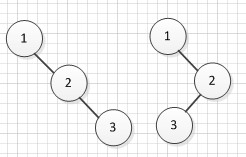转 http://www.cnblogs.com/rain-lei/p/3576796.html
由二叉树的前序和中序如何得到二叉树的后序呢?要给出答案,首先得明白什么是前序、中序、后序。
二叉树前序:遍历顺序为,根节点、左子树、右子树;中序:遍历顺序为,左子树、根节点、右子树;后序:遍历顺序为,左子树、右子树、根节点
可以发现,二叉树前序中的第一个节点为树的根节点root,然后找出root在中序里面的位置,就可以把前序和中序分别划分为左、右子树两个部分,然后递归调用即可。
举个例子,前序 5 3 2 4 8 6 10 中序 2 3 4 5 6 8 10
首先,5肯定是二叉树的根节点,然后5在中序里面的位置是3号(从0开始),此位置前面的是左子树中的节点,右面的是右子树的节点,即5 || 3 2 4|| 8 2 6 , 2 3 4 || 5 || 6 8 10,对红色的左子树序列、蓝色的右子树序列继续上述过程,直至结束。
由后序和中序求前序也是像类似的思想。但是仅仅知道前序和后序无法确定二叉的形状。比如前序 1 2 3 后序 3 2 1 则下面两种情况都符合

附二叉树前序和中序生成后序的代码
1 //二叉树 前序和中序得到后序
2 #include <stdio.h>
3 typedef struct node
4 {
5 int key;
6 struct node *left;
7 struct node *right;
8 }treeNode;
9
10 int pre_order[100];
11 int mid_order[100];
12
13 treeNode* construct_post_order(int pre_l, int pre_r, int mid_l, int mid_r)
14 {
15 if (pre_r - pre_l < 0)
16 {
17 return NULL;
18 }
19 treeNode *root;
20 root = new treeNode;
21 root->key = pre_order[pre_l];
22 if (pre_r == pre_l)
23 {
24 root->left = NULL;
25 root->right = NULL;
26 return root;
27 }
28 int index;
29 for (index = mid_l; index <= mid_r; index++)
30 {
31 if (mid_order[index] == pre_order[pre_l])
32 break;
33 }
34 root->left = construct_post_order(pre_l+1, pre_l+(index-mid_l), mid_l, index-1);
35 root->right = construct_post_order(pre_l+(index-mid_l)+1, pre_r, index+1, mid_r);
36 return root;
37 }
38
39 void post_Order(treeNode *root)
40 {
41 if(root != NULL)
42 {
43 post_Order(root->left);
44 post_Order(root->right);
45 printf("%d ", root->key);
46 }
47 }
48
49 int main()
50 {
51 int n;
52 printf("输入序列的长度
");
53 scanf("%d", &n);
54 printf("输入二叉树前序
");
55 for (int i = 0; i < n; i++)
56 scanf("%d", &pre_order[i]);
57 printf("输入二叉树中序
");
58 for (int i = 0; i < n; i++)
59 scanf("%d", &mid_order[i]);
60 treeNode *root = construct_post_order(0, n-1, 0, n-1);
61 printf("二叉树的后序为
");
62 post_Order(root);
63 printf("
");
64 scanf("%d", &n);
65
66 return 0;
67 }
